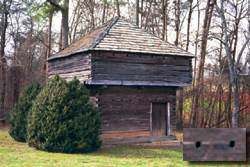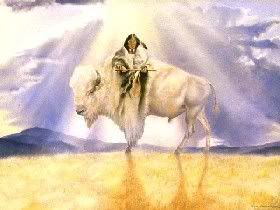
This article represents a brief introduction to the seven sacred ceremonies of the ancient Cherokee. For the most part, this information comes from Tribes that Slumber Indians of the Tennessee Region. It is never a good Idea to present information from a single source, especially with such a complex subject; however, time limited the ability to do more research.
Undoubtedly, each ceremony deserves several pages. Hopefully, in subsequent articles more in depth research will be possible, and details from a variety of sources can be included.
Two numbers are sacred to the Cherokee. Four is one number, it represented the four primary directions. At the center of their paths lays the sacred fire. Seven is the other and most sacred number. Seven is represented in the seven directions: north, south, east, west, above, bellow, and "here in the center" (Lewis & Kneberg, p. 175), the place of the sacred fire. Seven also represented the seven ancient ceremonies that formed the yearly Cherokee religious cycle. Six of the ceremonies took place every year, the seventh was celebrated every seventh year. They were held between March and November, based on the phases of the crescent or new moon. The First New Moon of Spring Ceremony was the first.
The First New Moon of Spring Ceremony took place "When the grass began to grow and the trees send out their pale new leaves..." (Lewis & Kneberg, p. 176-77), around the first new moon of March. This festival initiated the planting season and incorporated predictions concerning crop success or failure. It lasted seven days and included dancing and the re-lighting of the sacred fire by the fire maker. The ceremony included sacrificing a deer tongue in the fire. All the home fires were extinguished and rekindled from the sacred fire’s coals.
In August came the Green Corn Ceremony. It was performed when the new corn was ripe enough to eat. New corn was not to be eaten until after the ceremony took place. Messengers were sent to notify the towns of the nation about when the celebration would take place. Along the way they gathered seven ears of corn, each from a field of a different clan. After the messengers returned, the chief and his seven councilors fasted for six days. The ceremony began on the seventh. Again, the sacred fire was extinguished and rekindled. As with the First New Moon Ceremony, a deer tongue was sacrificed in the sacred fire. Kernels from the seven ears of corn that had been gathered from the clans were also sacrificed. A powder made from tobacco was sprinkled over the fire. Afterward, the Chief offered a prayer, dedicating the corn to the Creator. Food that was made from the new corn was brought to the townhouse and everyone was fed. The Chief and his councilors could only eat corn from the previous year’s crop for another seven days.
The Ripe Corn Ceremony was held in late September. It was the only ancient ceremony that survived into the 20th century. It celebrated the maturing of the corn crop and was held outdoors in the square ground. In the center of the ground a leafy tree was set. The celebration lasted four days and was also marked by feasting. During the ceremony a special dance was performed by the Chief’s right-hand man, as he danced he carried a green bough. A man’s dance was also performed in which each man carried a green bough. While it was taking place women were excluded from the square.
The third ceremony in the cycle was the Great New Moon Ceremony. It took place in October when the new moon appeared. Since autumn was the season when Cherokee stories say the world was created, it represented the new year celebration. Each family brought some produce from their field to share, such as corn, beans and pumpkins. Ceremonies included dancing, purification by immersing seven times in water, called "going to water" (Mooney, p. 230). The purification ceremony included predictions of health for the coming year by the "priest" using the sacred crystal.
Ten days after the New Moon Ceremony "Atohuna" was held, the reconciliation or "Friends Made" ceremony. The ceremony dealt with relationships between two people of the same or opposite sex. According to Tribes that Slumber, "these relationships were bonds of "eternal friendship in which each person vowed to regard the other as himself as long as they both lived." (p.183) It was a ceremony that was a pledge of universal fraternal or paternal love. It also "entailed reconciliation between those who had quarreled during the previous year." (p. 183) It symbolized the uniting of the people with the Creator and purification of body and mind. The New Moon Ceremony was said to have been the "most profoundly religious" (p. 183) of all the ceremonies. As with other observances, it also involved the rekindling of the sacred fire.
The sixth ceremony in the cycle was the Bounding Bush Ceremony. Few details are now known about this ceremony. Apparently, it was non-religious in nature and was celebrated by feasting and dancing. In the dance, men an women alternated in pairs. Two male leaders carried hoops with four spokes, each with a white feather at the end. The remainder of the dance is described as follows: other pairs in the center and at the end of the dancing column also carried hoops. All of the remaining couples carried white pine boughs in their right hands. The dance movement was circular, and in the center was a man with a small box. He danced around within the circle, singing as he did so, and as he passed by the dancers, each dropped a piece of tobacco in the box...(Lewis & Kneberg, p. 185)
The dance ended at midnight and was repeated on three successive nights. On the fourth night there was a feast before the dancing. Dancing resumed at midnight. This time people dropped pine needles into the box. At the end of the dance, near daylight, the dancers formed a circle around the sacred fire: "One by one, they advanced three times toward the fire, the third time tossing both tobacco and pine needles into the flames." (Lewis & Kneberg, p. 185)
Every seventh year the Uku Dance replaced the Great New Moon ceremony. In this dance the Chief, or Uku, led the nation in a ceremony of thanks giving and rejoicing. At the conclusion of the four day observance, the Chief was "reinvested with his religious and civil powers by his right-hand man. "Uku was one of several titles conferred upon him. During ‘Friends Made’ ceremony, for example, his title meant ‘one who renews heart and body.’ " (Lewis & Kneberg, p. 185) Before the chief performed his dance, he was ritually bathed by his councilors with water warmed by the "Honored Woman." He wore special regalia for the occasion and performed a dance around a specially prepared circle in the center of the square ground. Prior to dancing, the Chief was carried from a specially prepared throne, painted white. His feet were not allowed to touch the ground until he was brought to the circle. As he danced, he moved slowly around the circle, inclining his head to each spectator. Each spectator bowed in turn to the Chief.
As was stated at the start, this is only a brief description of the ancient Cherokee ceremonial cycle. There were also a number of other dances performed for special purposes throughout the year. It is hoped that more information on these, and Cherokee cosmology in general, can be presented in the future.
by Rob Wood
Sources:Lewis, Thomas M. N. and Madeline Kneberg. Tribes that Slumber Indians of the Tennessee Region. Knoxville, Tennessee: The University of Tennessee Press, tenth printing 1994; 196 pp.






























